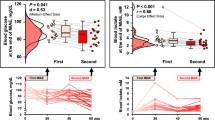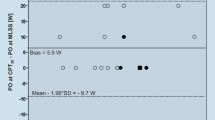Summary
The purposes of this investigation were to determine the validity of critical power (CP) as a measure of the work rate that can be maintained for a very long time without fatigue and to determine whether this corresponded with the maximal lactate steady-state (lass,max). Eight highly trained endurance cyclists (maximal oxygen uptake 74.1 ml · kg−1 · min−1, SD 5.3) completed four cycle ergometer tests to exhaustion at predetermined work rates (360, 425, 480 and 520 W). From these four co-ordinates of work and time to fatigue the regression of work limit on time limit was calculated for each individual (CP). The cyclists were then asked to exercise at their CP for 30 min. If CP could not be maintained, the resistance was reduced minimally to allow the subject to complete the test and maintain a blood lactate plateau. Capillary blood was sampled at 0, 5, 10, 20 and 30 min into exercise for the analysis of lactate. Six of the eight cyclists were unable to maintain CP for 30 min without fatigue. In these subjects, the mean power attained was 6.4% below that estimated by CP. Mean blood lactates (n = 8) reached a steady-state (8.9 mmol · l−1, SD 1.6) during the last 20 min of exercise indicating that CP slightly overestimated lass, max. Individual blood lactates during the last 20 min of exercise were more closely related to the y-intercept of the CP curve (r=0.78, P<0.05) than either CP (0.34, NS) or mean power output (r=0.42, NS). The present investigation has shown that highly trained endurance cyclists can tolerate previously unreported levels of blood lactate during 30 min of exercise at or near their CP. Blood lactates during continuous exercise are higher than at the same work rate during an incremental test. The CP provides a simple and inexpensive means of assessing the exercise intensity which can be maintained continuously, while avoiding the methodological difficulties associated with ventilatory and lactate thresholds.
Similar content being viewed by others
References
Brooks GA (1985) Anaerobic threshold: review of the concept and directions for future research. Med Sci Sports Exerc 17:22–31
Caiozzo VT, Davis JA, Ellis JF, Azus JL, Vandagriff R, Prietto CA, McMaster WC (1982) A comparison of gas exchange indices used to detect the anaerobic threshold. J Appl Physiol 53:1184–1189
Davis JA (1985) Anaerobic threshold: review of the concept and directions for future research. Med Sci Sports Exerc 17:6–18
Davis JA, Vodak P, Wilmore JH, Vodak J, Kurtz P (1976) Anaerobic threshold and maximal aerobic power for three modes of exercise. J Appl Physiol 41:544–550
Davis JA, Frank MH, Whipp BJ, Wasserman K (1979) Anaerobic threshold alterations caused by endurance training in middle aged men. J Appl Physiol 46:1039–1046
De Vries HA, Moritani T, Nagata A, Magnussen K (1982) The relation between critical power and neuromuscular fatigue as estimated from electromyographic data. Ergonomics 25:783–791
Hermansen L, Osnes JB (1972) Blood and muscle pH after maximal exercise in man. J Appl Physiol 32:304–308
Housh DJ, Housh TJ, Bauge SM (1989) The accuracy of the critical power test for predicting time to exhaustion during cycle ergometry. Ergonomics 32:997–1004
Jacobs I (1986) Blood lactate. Implications for training and sports performance. Sports Med 3:10–25
Jenkins DG, Quigley BM (1990) High intensity work and the critical power function. (in press)
Londeree BR (1986) The use of laboratory test results with long distance runners. Sports Med 3:201–213
Londeree BR, Ames SA (1975) Maximal steady-state versus state of conditioning. Eur J Appl Physiol 34:1–10
Maughan RJ (1982) A simple, rapid method for the determination of glucose, lactate, pyruvate, alinine, 3-hydroxybutyrate and acetoacetate on a single 20 μl blood sample. Clin Chim Acta 122:231–240
McArdle WD, Katch FI, Katch VL (1986) Exercise physiology: energy, nutrition and human performance. Lea & Febiger, Philadelphia, pp 637–641
Monod H, Scherrer J (1965) The work capacity of a synergic muscular group. Ergonomics 8:329–337
Moritani T, Nagata A, De Vries HA, Muro M (1981) Critical power as a measure of physical work capacity and anaerobic threshold. Ergonomics 24:339–350
Nagata A, Moritani T, Muro M (1983) Critical power as a measure of muscular fatigue and anaerobic threshold. In: Matsui H, Kafayassi K (eds) Biomechanics VIIIA, Human Kinetics, Champaign, Ill., pp 312–320
Nebelsick-Gullett LJ, Housh TJ, Johnson GO, Bauge SM (1988) A comparison between methods of measuring anaerobic work capacity. Ergonomics 31:1413–1419
Newsholme EA, Leech AR (1983) Biochemistry for the Medical Sciences. Wiley, Chichester, UK
Stegmann H, Kindermann W (1982) Comparison of prolonged exercise tests at the individual anaerobic threshold and fixed anaerobic threshold of 4 mmol/L lactate. Int J Sports Med 3:105–110
Stegmann H, Kindermann W, Schnabel A (1981) Lactate kinetics as individual anaerobic threshold. Int J Sports Med 2:160–165
Tanaka K, Matsuura Y, Kumagai S, Matsuzaka A, Hrakoba K, Asano K (1983) Relationship of anaerobic threshold and onset of blood lactate accumulation with endurance performance. Eur J Appl Physiol 52:51–56
Taylor HL, Buskirk E, Henschel A (1955) Maximal oxygen intake as an objective measure of cardiorespiratory performance. J Appl Physiol 8:73–80
Vandewalle H, Kapitaniak B, Grun S, Raveneau S, Monod H (1989) Comparison between a 30-s all-out test and a time-work test on a cycle ergometer. Eur J Appl Physiol 58:375–381
Walsh ML, Banister EW (1988) Possible mechanisms of the anaerobic threshold: a review. Sports Med 5:268–302
Wasserman K, Whipp BJ, Koyal SN, Beaver WL (1973) Anaerobic threshold and respiratory gas exchange during exercise. J Appl Physiol 35:236–243
Yeh MP, Gardner RM, Adams TD, Yanowitz FG, Crapo RO (1983) ‘Anaerobic threshold’: problems of determination and validation. J Appl Physiol 55:1178–1186
Yoshida T, Chida M, Ichioka M, Suda Y (1987) Blood lactate parameters related to aerobic capacity and endurance performance. Eur J Appl Physiol 56:7–11
Author information
Authors and Affiliations
Rights and permissions
About this article
Cite this article
Jenkins, D.G., Quigley, B.M. Blood lactate in trained cyclists during cycle ergometry at critical power. Eur J Appl Physiol 61, 278–283 (1990). https://doi.org/10.1007/BF00357613
Accepted:
Issue Date:
DOI: https://doi.org/10.1007/BF00357613




